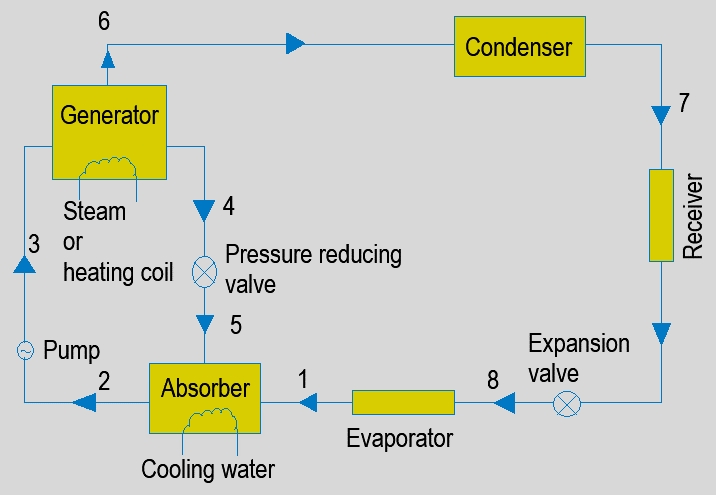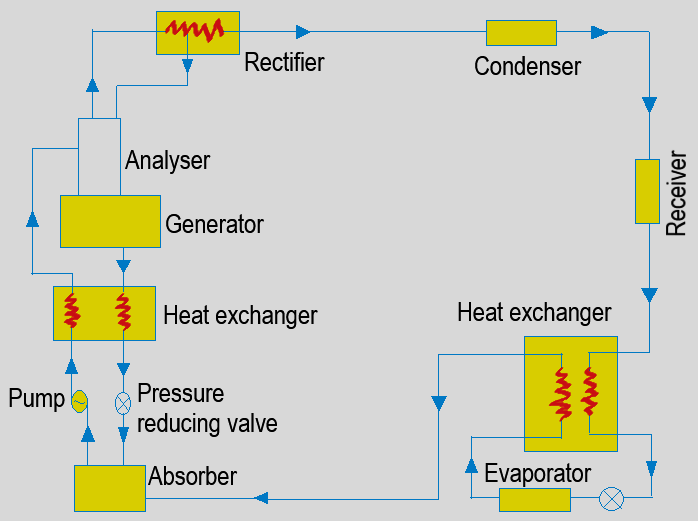This set of Refrigeration Multiple Choice Questions & Answers (MCQs) focuses on “Ideal VAR System”.
1. Which of the following is correct about VARS and VCRS?
a) VARS use mechanical energy, and VCRS use heat energy
b) VARS use heat energy, and VCRS use mechanical energy
c) Both use mechanical energy
d) Both use heat energy
View Answer
Explanation: VCRS use mechanical energy i.e., VCRS uses compressor which withdraws energy from the evaporator and drawn into condenser after compression. VARS use heat energy i.e., heat exchanger or heat generators are used and by which desired effect is achieved.
2. The compressor from VCRS is replaced by which of the following in the VARS?
a) Absorber, Pump
b) Generator, Pressure reducing valve
c) Absorber, Pump, Generator, and Pressure reducing valve
d) Absorber, Rectifier, Generator, and Pressure reducing valve
View Answer
Explanation: Compressor from the VCRS is replaced by an absorber, a pump, a generator, and a pressure reducing valve. These all components together do the same work as a compressor but by using the heat energy.
3. What is the purpose of using an absorber?

a) Heat absorption
b) Heat rejection
c) Pressure reduction
d) Work done
View Answer
Explanation: Vapour refrigerant from the evaporator enters the absorber. Cooling water is circulated to transfer the heat, and refrigerant’s strong solution is discharged to the generator.
4. What is the purpose of using a pump?

a) Heat absorption
b) Heat rejection
c) Pressure reduction
d) Pressure increment
View Answer
Explanation: The strong solution discharging from the absorber is pumped to the generator using a liquid pump. The liquid pump increases the pressure up to 10 bar.
5. What is the purpose of using a generator?

a) Heat supplied
b) Heat rejection
c) Pressure reduction
d) Pressure increment
View Answer
Explanation: Generator generates heat. From the generator, heat is supplied to the refrigerant, and the strong refrigerant is heated further by using some external source like gas or steam.
6. What is the purpose of using a pressure reducing valve?

a) Heat supplied
b) Heat rejection
c) Pressure reduction
d) Pressure increment
View Answer
Explanation: As the name suggests, pressure reducing valve reduces the pressure of a weak solution of refrigerant, and a weak solution is discharged into an absorber to make again it a strong solution.
7. What is the purpose of using an analyzer?

a) Heat supplied
b) Removal of unwanted water particles
c) Pressure reduction
d) Removal of unwanted ammonia particles
View Answer
Explanation: Analyzer is used to remove unwanted particles from entering the condenser. If the unwanted water particles enter the condenser, then these particles will enter the expansion valve too. These particles will freeze if passed through an expansion valve and will choke the pipeline.
8. What is the purpose of using a rectifier?

a) Removal of all water particles by cooling
b) Heat supplied
c) Pressure reduction
d) Removal of unwanted ammonia particles
View Answer
Explanation: Water vapors are not entirely removed in an analyzer, to condensate pure ammonia refrigerant, rectifier or dehydrator is used. Its function is to cool refrigerant coming out of an analyzer and condensate from rectifier returns to the analyzer by using the drip pipe.
9. What is the purpose of using a heat exchanger between the pump and the generator?

a) Cool the strong hot solution
b) Heat the strong hot solution
c) Heat the weak hot solution
d) Cool the weak hot solution
View Answer
Explanation: Heat exchanger between the pump and the generator is used to cool the weak hot solution of ammonia and water. The heat removed from the weak solution increases the temperature of the strong solution discharging the pump and entering the generator. Use of heat exchanger increases the economy of the plant.
10. What is the purpose of using a heat exchanger between condenser and evaporator?

a) Heat the water particles
b) Heat the strong hot solution
c) Heat the weak hot solution
d) Sub-cooling of the refrigerant
View Answer
Explanation: Heat exchanger between the condenser and the evaporator is used to sub-cool the refrigerant. Heat exchanger acts as a liquid sub-cooler. Refrigerant discharging from the condenser is sub-cooled by the low-temperature ammonia vapour in the evaporator.
Sanfoundry Global Education & Learning Series – Refrigeration & Air Conditioning.
To practice all areas of Refrigeration & Air Conditioning, here is complete set of 1000+ Multiple Choice Questions and Answers.
If you find a mistake in question / option / answer, kindly take a screenshot and email to [email protected]
- Practice Mechanical Engineering MCQs
- Check Refrigeration & Air Conditioning Books
- Check Mechanical Engineering Books
- Apply for Mechanical Engineering Internship
